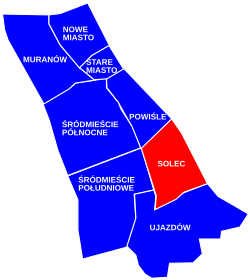Solec, Warsaw
Solec | |
|---|---|
Warsaw neighborhood | |
 Contemporary Solec | |
 Location of Solec neighborhood (red) in the district of Śródmieście-Downtown (navy blue) |
Solec (Polish pronunciation:
History
Middle Ages–1700s
The village of Solec was first documented in 1381 and in 1382

Solec was granted
In 1770,
1800–1939

The early 19th century brought considerable
With industrialization came
1939–contemporary

The
In post-war years, the authorities of the Polish People's Republic attempted to remove the previous slum and industrial character of the neighbourhood. The factories with most workhouses were not reconstructed and were instead replaced by socialist tower blocks and apartment buildings in the 1960s and 1970s.[12] The tram line ceased operation in 1960.
Since 1989, the suburb has undergone a major transformation with the construction of new housing estates, hotels, commercial facilities and gradual modernization.[12]
See also
References
- ^ "Ulice Twojego Miasta | Warszawa | Solec". ulicetwojegomiasta.pl.
- ^ a b "Rynek Solecki – Jak solą w Warszawie handlowano". 16 August 2017.
- ^ "Isia: "To też są zabytki – słona ulica"". nepomuki.pl.
- ^ "ulica Solec – Powiśle – Warszawa Śródmieście". www.warszawska.waw.pl.
- ^ "Rynek Solecki – Ulice – Dzielnica Śródmieście m. st. Warszawy". srodmiescie.warszawa.pl.
- ^ a b "Warszawa – barokowy pałac Symonowiczów " Zamki Rotmanka".
- ^ "Warszawa – Ogrody "Na Książęcem". Atrakcje turystyczne Warszawy. Ciekawe miejsca Warszawy". www.polskaniezwykla.pl.
- ^ "Polish History – 186 years ago the November uprising".
- ^ "Powiśle". Warszawy historia ukryta.
- ^ "Kolonia Profesorska – Ujazdów – Warszawa – warto zobaczyć w iwaw". www.iwaw.pl.
- ^ "Powstanie Warszawskie 1944 – Oficjalna strona Stowarzyszenia Pamięci Powstania Warszawskiego 1944". www.sppw1944.org.
- ^ a b Gniazdowska, Magda (23 January 2014). "Ulica Solec". mojepowisle.com.
